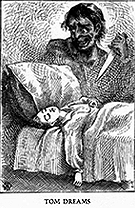When people were talking about
censoring Huckleberry Finn last week, I didn't realize they were planning to do the same to
Tom Sawyer:
Upcoming NewSouth 'Huck Finn' Eliminates the 'N' Word By Marc SchultzRather than see Twain's most important work succumb to that fate, Twain scholar Alan Gribben and NewSouth Books plan to release a version of Huckleberry Finn, in a single volume with The Adventures of Tom Sawyer, that does away with the "n" word (as well as the "in" word, "Injun") by replacing it with the word "slave."
"This is not an effort to render Tom Sawyer and Huckleberry Finn colorblind," said Gribben, speaking from his office at Auburn University at Montgomery, where he's spent most of the past 20 years heading the English department. "Race matters in these books. It's a matter of how you express that in the 21st century."Educator Debbie Reese examines the problems in
Tom Sawyer:
An American Indian perspective on changing "Injun" to "Indian" in TOM SAWYERSummary: The first Indian that Twain introduces readers to is an unnamed figure in Tom's imagination. This takes place in chapter eight on page 74. Tom has been rebuffed by the girl he's sweet on (Becky) and runs off to the woods. There, Tom thinks about running away to "join the Indians" where he'll "hunt buffaloes and go on the warpath in the mountain ranges and the trackless great plains of the Far West." When he returns, he'll be with "a great Indian chief, bristling with feathers, hideous with paint." He'll go into Sunday-school "with a blood-curdling war-whoop."
Deb's comments: Tom's image reflects America's love/hate attitude towards American Indians. On one hand, we're admired and on the other, we're feared. Or--I should say--IMAGES of us are admired and feared. Tom wants to join Indians who (he imagines) are living the good life out west, hunting buffaloes. He is drawn to the warlike image, too, as he images going on the warpath with the Indians of his imagination. Tom dwells more on the aggressive warlike image of Indians in feathers and paint who utter sounds that terrorize courageous Christians and settlers.In the next chapter, Injun Joe is helping a doctor and his assistant dig up a body in a graveyard. Injun Joe tells the doctor he has a score to settle because: "The Injun blood ain't in me for nothing." The "half-breed" Indian circles the doctor--"creeping, catlike and stooping"--before stabbing him.
Deb's comments: As developed by Twain, "Injun Joe" is a vengeful, lying murderer who moves like a cat. In framing "Injun Joe" as animal-like, Twain is not alone. Authors then and now do it. A recent example is seen in James Crowley's Blackfeet characters who gnaw on bones.
And, he's a half-breed whose Indian blood/identity is the reason he's a vengeful, lying murderer.(Excerpted from Debbie Reese's
American Indians in Children's Literature, 1/10/11.)
Comment: Reese goes through the whole book analyzing it in the same vein. She concludes that changing "Injun" to "Indian" and "half-breed" to "half-blood" won't make much difference. Injun Joe is still a one-dimensional savage killer regardless of the words used. The book doesn't belong in any curriculum except to study racism in literature.
For more on the subject, see
New Huck Finn Eliminates "Injun" and
Is Huck Finn Racist?


No comments:
Post a Comment